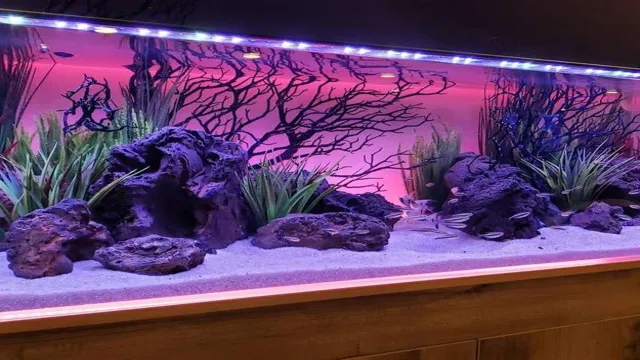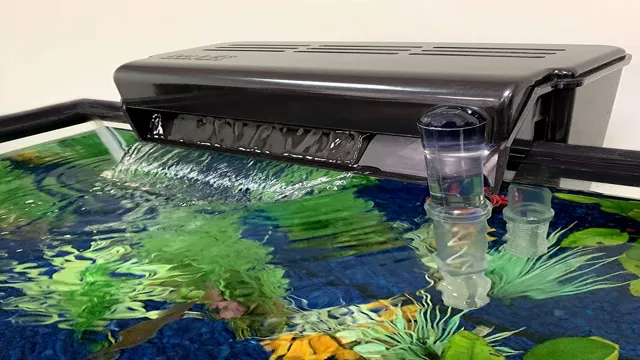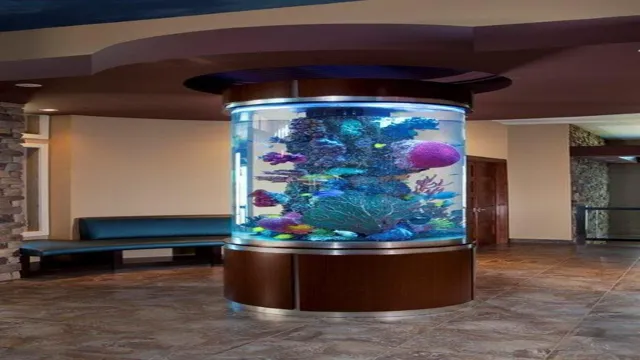Are you looking to add some natural beauty to your aquarium while improving your fish’s habitat? Making your own wood for your aquarium may seem daunting, but it doesn’t have to be! In this step-by-step guide, we’ll walk you through the process of making wood for your aquarium. Not only will this save you money compared to buying it from a store, but it also ensures that the wood is safe and free of any harmful chemicals. You’ll learn everything from selecting the right wood to preparing and curing it, so your fish can have a comfortable and sustainable environment.
Whether you’re a novice or an experienced aquarist, this guide will help you create a stunning aquarium that your fish will love. So grab your saws and chisels, and let’s get started on creating some custom-made wood for your aquarium!
Choosing the Right Type of Wood
When it comes to making wood for aquariums, it is important to choose the right type of wood. Not all types of wood are safe for aquarium use and can potentially harm your aquatic pets. It is best to use woods that are dense and do not easily decompose, as well as woods that do not contain high levels of sap, oils, or tannins, which can discolor the water and cause pH imbalances.
Some good options include driftwood, mopani wood, spider wood, and manzanita wood. These types of wood also provide great aesthetic appeal, creating a natural and beautiful environment for your aquarium inhabitants. By choosing the right type of wood, you can maintain a healthy and thriving aquatic environment for your pets.
Factors to Consider
When it comes to choosing the right type of wood for your project, there are several factors to consider. First and foremost, you’ll want to think about the level of durability you need. Some types of wood, like oak or teak, are incredibly strong and resistant to wear and tear, making them great options for outdoor furniture or high-traffic areas.
Others, like pine or cedar, are a bit softer and may be better suited for indoor pieces. You’ll also want to think about the aesthetics you’re going for. Do you want a natural, rustic look or something more refined and polished? Certain woods, like cherry or walnut, have a rich, warm tone that can add a touch of elegance to any project.
Keep in mind the cost as well, as some woods can be quite expensive. Ultimately, the type of wood you choose will depend on a combination of factors, including your budget, the look you’re going for, and the specific needs of your project.

Types of Wood That Work Best for Aquariums
When it comes to choosing the right type of wood for your aquarium, it’s important to consider a few factors. Firstly, you want to make sure that the wood is safe and won’t leach harmful chemicals into the water. Secondly, you want to choose a wood that will not rot quickly and lasts for a long time.
Some of the best types of wood for aquariums are Malaysian driftwood, spiderwood, and mopani wood. Malaysian driftwood is a popular option as it has a natural branch-like appearance and is known to lower the pH levels in the water. Spiderwood is also a great choice as it has a unique twisted shape that adds character to your aquarium.
Mopani wood is another durable and long-lasting option, with a distinct look thanks to its dark color and textured surface. No matter which type of wood you choose, just remember to properly clean and prepare it before adding it to your aquarium.
Preparing the Wood
If you’re planning to add wood to your aquarium, it’s essential to prepare it properly to prevent any potential harm to your aquatic pets. Firstly, choose the right type of wood that won’t release any harmful chemicals into the water. Popular options include driftwood, manzanita, and mopani wood.
Once you’ve chosen your wood, thoroughly rinse it to remove any debris or dirt. It’s also important to soak it in water for a minimum of two weeks to get rid of any tannins that could discolor the water or lower the pH level. During this time, change the water regularly to ensure it stays clean.
After soaking, you can sterilize the wood by boiling it or baking it in the oven. However, ensure it’s completely dry before adding it to the aquarium. With proper preparation, adding wood to your aquarium can create a beautiful, natural-looking environment for your aquatic pets to enjoy.
Cleaning and Boiling the Wood
When it comes to preparing wood for woodworking projects, cleaning and boiling the wood are important steps. First, it is essential to remove any dirt or debris from the wood. This can be done by using a soft brush or cloth to gently wipe away the dust. (See Also: How to Make a Low Profile Aquarium Tank: A Step-by-Step Guide)
Next, the wood should be soaked in water and boiled for at least an hour. Boiling the wood helps to kill any bugs or pests that may be living inside the wood, and it also helps to remove any sap or resin that may be present. Once the wood has been boiled, it should be left to dry for a few days before it is used for woodworking projects.
This process may seem simple, but it can make a big difference in the quality of the finished product. So, take the time to properly prepare your wood before embarking on your woodworking project – your end result will be well worth the effort.
Soaking the Wood in Water
If you’re looking to use wood for any home improvement or renovation project, it’s crucial to prepare it beforehand. One method of doing so is by soaking the wood in water. Soaking the wood helps to make it more pliable and easier to work with.
The water causes the wood fibers to swell, making them more resilient and less likely to split or break. It also helps to remove any excess sap or dirt that may be present on the wood’s surface. Depending on the size and type of wood you’re using, the soaking time will vary.
Smaller pieces may only need an hour or two, while larger pieces may require several days to become fully saturated. Just remember to dry the wood completely after it’s been soaked to prevent any warping or decay. With this method, you’ll be able to prepare your wood for any project and make your DIY experience much smoother!
Allowing the Wood to Dry Completely
If you’re looking to work with wood for your next project, it’s essential to properly prepare the wood. Allowing the wood to dry completely is an essential step in this process. It’s important to note that freshly cut wood can be up to 50% moisture, which can lead to warping, cracking, and even rot over time.
To prevent this, you should stack the wood in a dry location with plenty of air circulation. This will allow the moisture to escape slowly and evenly, resulting in dry and stable wood. Once the wood is dry, you can begin your project knowing that the wood will remain in good condition for years to come.
By taking the time to prepare the wood, you’re ensuring a beautiful and long-lasting finished product.
Adding the Wood to Your Aquarium
If you’re looking to add some natural elements to your aquarium, adding wood can give your tank a unique and aesthetically pleasing look. But before adding wood to your aquarium, it’s important to make sure the wood is safe for your fish and the overall environment. First, choose a hardwood that has been cured and soaked to remove any excess tannins or toxins.
Then, clean the wood thoroughly by brushing it with a soft bristle brush and boiling it in water for at least 30 minutes to eliminate any remaining bacteria or parasites. Once the wood has been prepared, you can add it to your aquarium as a decorative feature or to provide hiding places for your fish. With careful preparation and regular maintenance, your wood can last for years and enhance the natural beauty of your aquatic environment.
Placing the Wood in the Tank
When it comes to adding wood to your aquarium, there are a few things to keep in mind to ensure the health and happiness of your aquatic pets. First, choose a type of wood that is safe for aquarium use, such as driftwood or mangrove wood. Then, thoroughly rinse the wood to remove any dirt, debris, or chemicals that could harm your fish.
Once the wood is clean, it’s time to place it in the tank. Depending on the size of the wood and your aquarium, you may need to adjust the placement a few times to find the perfect spot. Not only does adding wood to your aquarium create a natural look and feel, but it also provides a hiding place and a source of food for some types of fish and invertebrates. (See Also: How to Get Rid of Snails in Your Freshwater Aquarium: 6 Proven Strategies)
Just make sure to monitor the water chemistry regularly to ensure that the wood isn’t negatively impacting the pH levels or water quality in your aquarium. Overall, adding wood to your aquarium can be a fun and rewarding way to create a beautiful and healthy underwater environment for your fish.
Monitoring and Adjusting the pH Levels
When it comes to adding wood to your aquarium, it’s important to consider the impact it can have on your tank’s pH levels. The type of wood you choose can make a significant difference. For instance, driftwood can help lower the pH levels of your tank, making it more suitable for certain species of fish and plants.
However, it’s important to monitor your pH levels regularly to ensure they don’t drop too low and harm your aquatic life. You may need to adjust the pH levels accordingly by adding chemicals or changing the type of wood you’re using. It’s also important to note that some types of wood, such as cedar, can be harmful to your tank’s inhabitants and should be avoided.
Overall, adding wood to your aquarium can be a great way to enhance its natural aesthetic while also providing benefits for your aquatic life. Just be sure to monitor and adjust your pH levels accordingly to ensure a healthy and thriving environment for your fish and plants.
Maintaining the Wood
If you’ve decided to add wood to your aquarium, it’s important to know how to maintain it properly. First, you want to select a high-quality type of wood that won’t rot over time. Driftwood or Manzanita wood are great options because they are resistant to decay and have unique shapes that can enhance the look of your aquarium.
Once you have selected your wood, you’ll need to prepare it for use in your tank. This involves soaking it in water for several days to remove any dirt or debris that may be on the wood. It’s important to change the water daily to prevent any bacteria from building up.
Once the wood is clean and ready to use, you can add it to your tank. However, over time the wood will start to break down and decompose. To prevent this, you’ll need to maintain the wood by scraping off any excess algae or debris and occasionally boiling it to kill off any bacteria.
By following these steps, you can make sure your wood stays healthy and vibrant for your aquarium.
Cleaning and Trimming as Needed
Maintaining the Wood of your house or furniture is essential for its longevity and to keep its aesthetic appeal intact. Regular cleaning and trimming are necessary to prevent the accumulation of dirt, debris, and moisture, which can lead to rotting or corrosion of the wood. Depending on the type of wood, different cleaning methods may be required.
For example, softwood may need a mild soap and water solution, while hardwood may require specialized wood cleaners. Similarly, trimming rough spots and splinters can prevent accidents and extend the life of the wood. However, it’s crucial to avoid over-trimming, as it can weaken the wood and damage it.
So, it’s best to consult a professional if you’re unsure about how much to trim. By maintaining your wood regularly, you can ensure its beauty and durability for years to come.
Avoiding Common Issues
Maintaining the wood is crucial to ensure longevity and an aesthetically pleasing appearance. One common issue that arises is wood rot, which can be prevented by keeping the wood dry and sealing it with a waterproof sealant. Another concern is warping or bending, which is caused by exposure to moisture and sunlight.
To prevent this, it’s important to store the wood in a dry and cool area, preferably indoors, and to avoid direct sunlight exposure. Regular cleaning and sanding may also help to maintain the wood’s appearance and prevent the buildup of dirt or stains. By taking these simple steps, you can extend the life of your wood and enjoy its natural beauty for years to come. (See Also: How to Make Jello Aquarium Cups: Step-by-Step Guide with Fun Underwater Theme)
Conclusion: Enjoy Your Beautifully Decorated Aquarium
In conclusion, making wood for your aquarium is not only a way to enhance your tank’s aesthetic, but it can also provide a natural habitat for your fish. With a little bit of patience and creativity, anyone can turn ordinary wood into a beautiful and functional addition to their aquatic ecosystem. Just be sure to use safe, non-toxic materials, take the time to properly sanitize your wood, and keep a close eye on the water chemistry to ensure a healthy environment for your finned friends.
Remember, there’s no need to buy expensive decorations when you can DIY your way to a stunning aquarium! As they say, give a fish a toy and it’ll play for a day; give a fish a piece of DIY wood and it’ll thank you for life.”
FAQs
What type of wood is suitable for aquariums?
The best type of wood for aquariums is driftwood as it releases tannins slowly and won’t harm the fish.
How can I make sure the wood is safe for my aquarium fish?
Always boil the wood for several hours to remove any toxins and bacteria, and soak it in water for a few days to leach out tannins before adding it to your aquarium.
Can I use any type of wood for my aquarium?
No, not all types of wood are safe for aquariums. Only use untreated, pH-neutral wood like driftwood or mopani wood.
How do I know if the wood is pH-neutral?
You can test the pH level of the wood by soaking a small piece in water and testing it with a pH test kit. If the pH is within 6.5-7.5, it’s safe for your aquarium.
How much wood should I add to my aquarium?
It’s best to add 1-2 pieces of wood that are proportional to the size of your tank. Too much wood can lower the pH and release too many tannins.
How can I clean the wood without harming my aquarium?
Never use soap or bleach to clean the wood. Instead, use a soft brush and warm water to gently scrub away any debris.
How long can I expect the wood to last in my aquarium?
It depends on the type of wood and the conditions of your aquarium. Generally, driftwood can last up to 2-3 years before it begins to break down and needs to be replaced.







